Answered step by step
Verified Expert Solution
Question
1 Approved Answer
Case 2.12. Boeing: Decades of Major Ethical Setbacks from Lockheed Document Heists to the 737 MAX Boeing, founded in 1916, has long been an
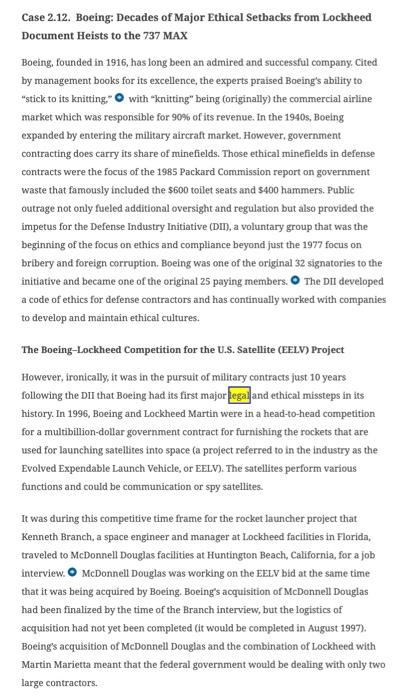


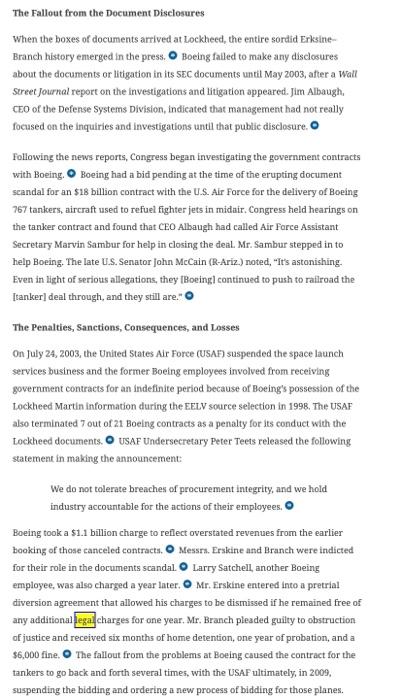
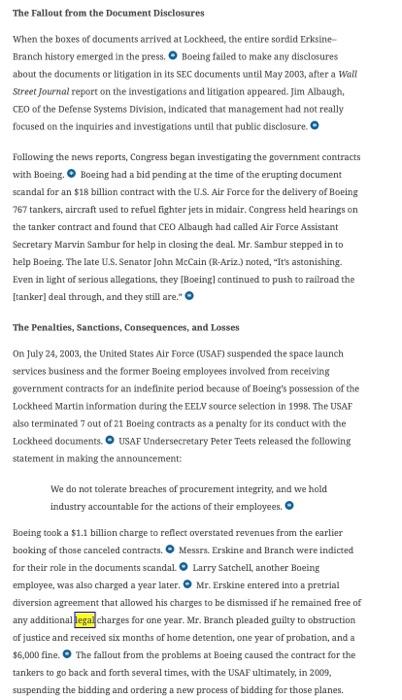
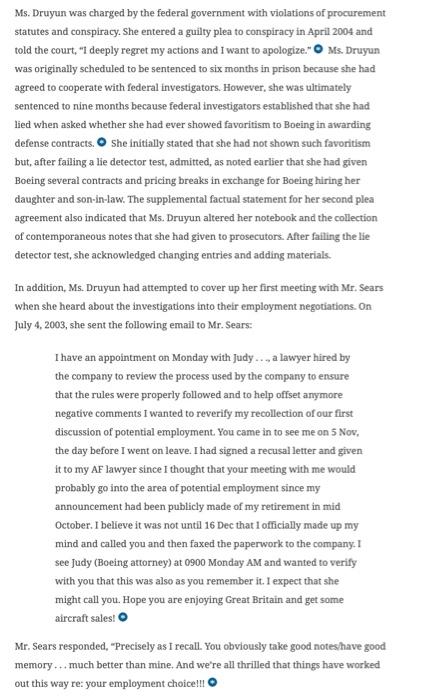
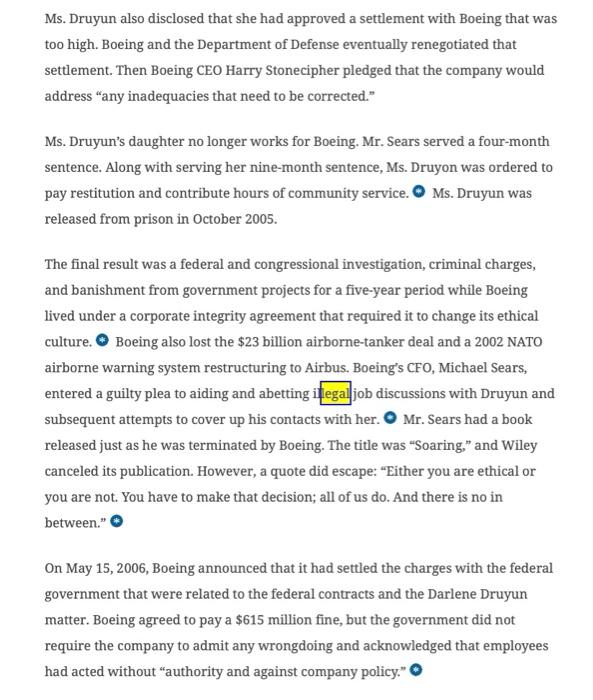
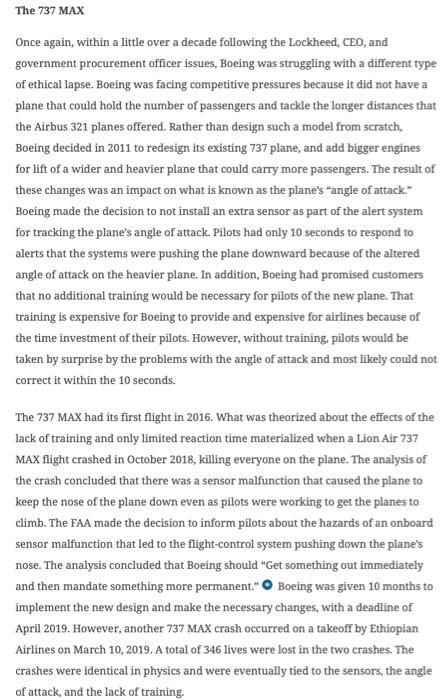
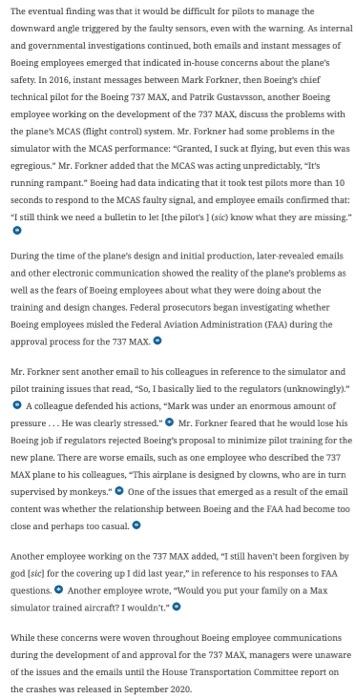

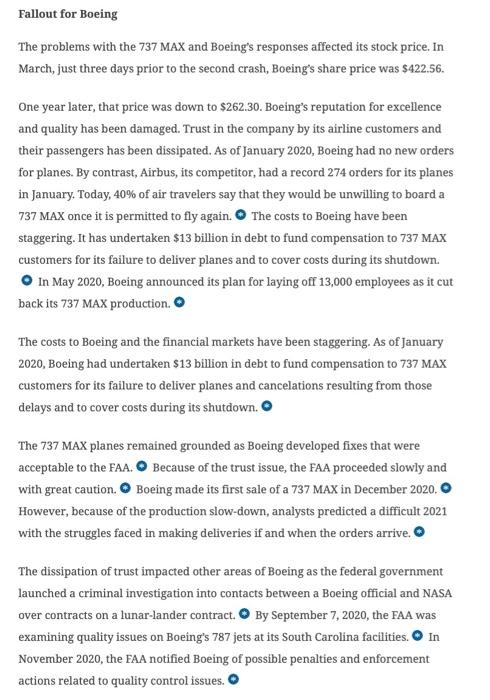
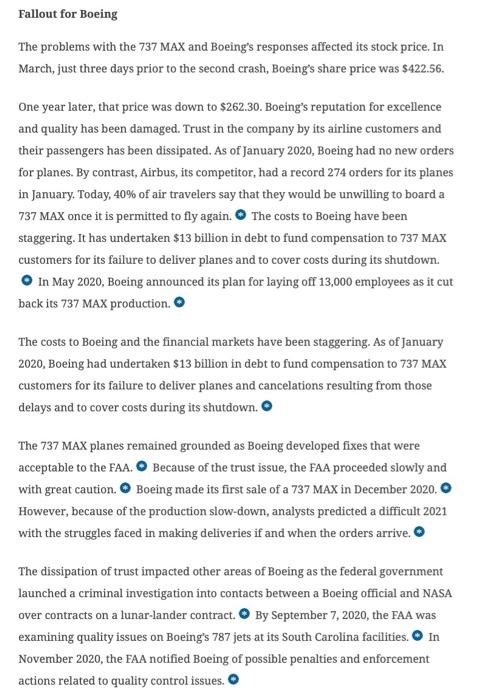
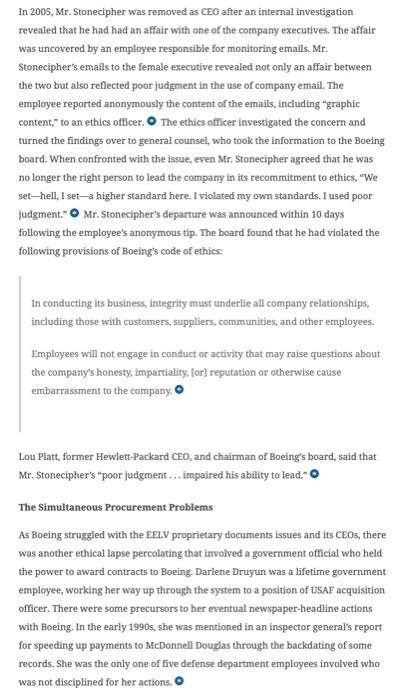

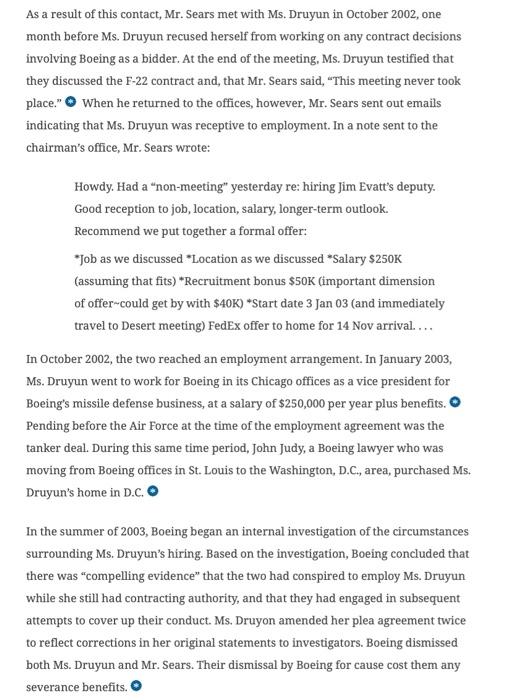
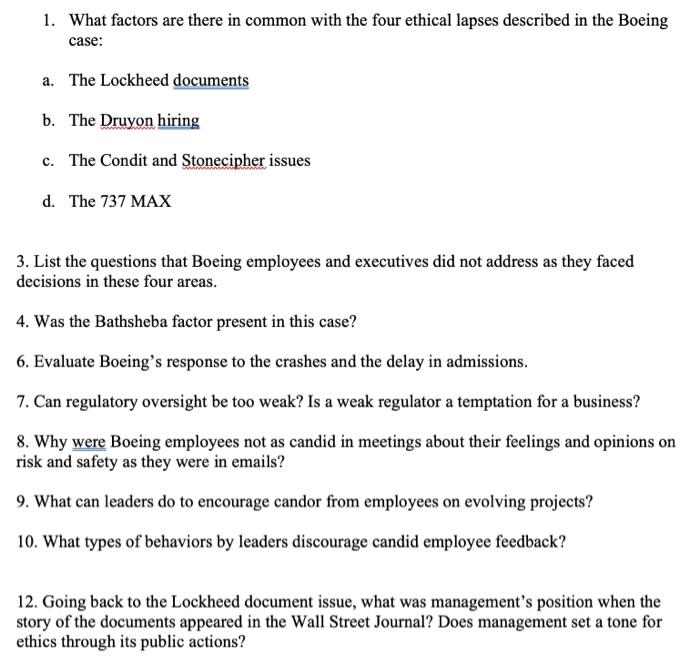
Case 2.12. Boeing: Decades of Major Ethical Setbacks from Lockheed Document Heists to the 737 MAX Boeing, founded in 1916, has long been an admired and successful company. Cited by management books for its excellence, the experts praised Boeing's ability to "stick to its knitting," with "knitting" being (originally) the commercial airline market which was responsible for 90% of its revenue. In the 1940s, Boeing expanded by entering the military aircraft market. However, government contracting does carry its share of minefields. Those ethical minefields in defense contracts were the focus of the 1985 Packard Commission report on government waste that famously included the $600 toilet seats and $400 hammers. Public outrage not only fueled additional oversight and regulation but also provided the impetus for the Defense Industry Initiative (DII), a voluntary group that was the beginning of the focus on ethics and compliance beyond just the 1977 focus on bribery and foreign corruption. Boeing was one of the original 32 signatories to the initiative and became one of the original 25 paying members. The DII developed a code of ethics for defense contractors and has continually worked with companies to develop and maintain ethical cultures. The Boeing-Lockheed Competition for the U.S. Satellite (EELV) Project However, ironically, it was in the pursuit of military contracts just 10 years following the DII that Boeing had its first major legal and ethical missteps in its history. In 1996, Boeing and Lockheed Martin were in a head-to-head competition for a multibillion-dollar government contract for furnishing the rockets that are used for launching satellites into space (a project referred to in the industry as the Evolved Expendable Launch Vehicle, or EELV). The satellites perform various functions and could be communication or spy satellites. It was during this competitive time frame for the rocket launcher project that Kenneth Branch, a space engineer and manager at Lockheed facilities in Florida, traveled to McDonnell Douglas facilities at Huntington Beach, California, for a job interview. McDonnell Douglas was working on the EELV bid at the same time that it was being acquired by Boeing. Boeing's acquisition of McDonnell Douglas had been finalized by the time of the Branch interview, but the logistics of acquisition had not yet been completed (it would be completed in August 1997). Boeing's acquisition of McDonnell Douglas and the combination of Lockheed with Martin Marietta meant that the federal government would be dealing with only two large contractors. Near the end of his interview at McDonnell Douglas, Mr. Branch showed the participants in the interview process a copy of Lockheed's proposed presentation for the government project. Six months after his interview, in January 1997, Branch began work at Boeing on the $5 billion EELV project. The pressure for Boeing to win the contract became intense, and Boeing executive Frank Slazer, the director of business development, encouraged Boeing employees working on EELV to develop "an improved Lockheed Martin EELV competitive assessment." He also encouraged the employees to find former Lockheed employees to get their thoughts and impressions about the project. Sometime during the first quarter of 1997, Lockheed sent Mr. Branch a letter reminding him of his confidentiality agreement with Lockheed and his duty to not disclose any proprietary information at Boeing. During this same period, Kimberly Tran, a Boeing software engineer, filed a report that she had seen Mr. Branch in the hallway with a notebook that had the Lockheed logo on the outside. She was reprimanded by Tom Alexiou, Branch's supervisor, for not going first to her own supervisor. Although Boeing claimed to have begun an investigation as a result of Tran report, it admitted that there was no record of that investigation. Shortly after, Boeing was awarded 19 of the planned 28 rocket launches in the EELV, a total contract value of $1.88 billion. After the Boeing contract award, rumblings began in both the industry and government agencies about Boeing's possible possession of Lockheed proprietary documents during the time of the bids. In June 1999, Steve Griffin, a Boeing engineer, heard William Erskine, an EELV project engineer, boast that he had offered Branch the Boeing job in exchange for the Lockheed EELV proposal. The following was an exchange between the two: Griffin: Erskine: We just took a Procurement Integrity Law class. I can't believe you did that. I was hired to win... and I was going to do whatever it took to do it. Mr. Griffin reported these remarks to the Boeing Human Resources Representative. Coincidentally, Mr. Griffin's wife, Bridget Griffin, who was an engineer with Lockheed at this time, made a similar report outlining Mr. Erskine's remarks to a Lockheed ethics officer. The issues were then reported to Boeing attorney, Mark Rabe, who interviewed both Messrs. Branch and Erskine with Mr. Branch disclosing a stack of Lockheed documents that he had in his office. Boeing notified Lockheed that it had found Lockheed documents and returned them to Lockheed. Mr. Rabe assured Lockheed that Boeing did not use any of the information in the EELV proposal. Mr. Branch was then suspended. However, six months later, Boeing attorneys found another 15 Lockheed documents; they returned them to Lockheed but did not disclose that their internal investigation found that Messrs. Branch and Erskine had used proprietary information. Boeing then terminated Messrs. Branch and Erskine, who then filed suit against Boeing for wrongful termination. The Litigation and Discovery of Additional Documents During discovery in the case, Lockheed asked to receive copies of what turned out to be boxes of Lockheed documents that Boeing had but had not previously disclosed or return to Lockheed. The judge refused to grant the request. However, in April 2002, Boeing's assistant general counsel and vice president wrote to Lockheed to return the documents and offer that she had no explanation as to why the documents were not returned to Lockheed in 1997. She added: "At any rate, all documents have now been transmitted to you and I would like to apologize for the series of errors that have occurred in handling this case." Just days later, Boeing sent an additional 11 boxes of documents to Lockheed. The documents in the boxes had the Lockheed Martin logo and were stamped "Proprietary." In June 2003, Boeing turned over another 1,850 pages of proprietary documents. The judge terminated the wrongful discharge suit brought by Messrs. Erskine and Branch and required them to pay Boeing's legal fees. However, the two men signed agreements promising not to disclose details about the case or discuss it with the media in exchange for Boeing waiving its rights to collect its legal fees. The Fallout from the Document Disclosures When the boxes of documents arrived at Lockheed, the entire sordid Erksine- Branch history emerged in the press. Boeing failed to make any disclosures about the documents or litigation in its SEC documents until May 2003, after a Wall Street Journal report on the investigations and litigation appeared. Jim Albaugh, CEO of the Defense Systems Division, indicated that management had not really focused on the inquiries and investigations until that public disclosure. Following the news reports, Congress began investigating the government contracts with Boeing. Boeing had a bid pending at the time of the erupting document scandal for an $18 billion contract with the U.S. Air Force for the delivery of Boeing 767 tankers, aircraft used to refuel fighter jets in midair. Congress held hearings on the tanker contract and found that CEO Albaugh had called Air Force Assistant Secretary Marvin Sambur for help in closing the deal. Mr. Sambur stepped in to help Boeing. The late U.S. Senator John McCain (R-Ariz.) noted, "It's astonishing. Even in light of serious allegations, they [Boeing) continued to push to railroad the [tanker] deal through, and they still are." O The Penalties, Sanctions, Consequences, and Losses On July 24, 2003, the United States Air Force (USAF) suspended the space launch services business and the former Boeing employees involved from receiving government contracts for an indefinite period because of Boeing's possession of the Lockheed Martin information during the EELV source selection in 1998. The USAF also terminated 7 out of 21 Boeing contracts as a penalty for its conduct with the Lockheed documents. USAF Undersecretary Peter Teets released the following statement in making the announcement: We do not tolerate breaches of procurement integrity, and we hold industry accountable for the actions of their employees. Larry Satchell, another Boeing Boeing took a $1.1 billion charge to reflect overstated revenues from the earlier booking of those canceled contracts. Messrs. Erskine and Branch were indicted for their role in the documents scandal. employee, was also charged a year later. Mr. Erskine entered into a pretrial diversion agreement that allowed his charges to be dismissed if he remained free of any additional legal charges for one year. Mr. Branch pleaded guilty to obstruction of justice and received six months of home detention, one year of probation, and a $6,000 fine. The fallout from the problems at Boeing caused the contract for the tankers to go back and forth several times, with the USAF ultimately, in 2009, suspending the bidding and ordering a new process of bidding for those planes. The Fallout from the Document Disclosures When the boxes of documents arrived at Lockheed, the entire sordid Erksine- Branch history emerged in the press. Boeing failed to make any disclosures about the documents or litigation in its SEC documents until May 2003, after a Wall Street Journal report on the investigations and litigation appeared. Jim Albaugh, CEO of the Defense Systems Division, indicated that management had not really focused on the inquiries and investigations until that public disclosure. Following the news reports, Congress began investigating the government contracts with Boeing. Boeing had a bid pending at the time of the erupting document scandal for an $18 billion contract with the U.S. Air Force for the delivery of Boeing 767 tankers, aircraft used to refuel fighter jets in midair. Congress held hearings on the tanker contract and found that CEO Albaugh had called Air Force Assistant Secretary Marvin Sambur for help in closing the deal. Mr. Sambur stepped in to help Boeing. The late U.S. Senator John McCain (R-Ariz.) noted, "It's astonishing. Even in light of serious allegations, they [Boeing) continued to push to railroad the [tanker] deal through, and they still are." O The Penalties, Sanctions, Consequences, and Losses On July 24, 2003, the United States Air Force (USAF) suspended the space launch services business and the former Boeing employees involved from receiving government contracts for an indefinite period because of Boeing's possession of the Lockheed Martin information during the EELV source selection in 1998. The USAF also terminated 7 out of 21 Boeing contracts as a penalty for its conduct with the Lockheed documents. USAF Undersecretary Peter Teets released the following statement in making the announcement: We do not tolerate breaches of procurement integrity, and we hold industry accountable for the actions of their employees. Larry Satchell, another Boeing Boeing took a $1.1 billion charge to reflect overstated revenues from the earlier booking of those canceled contracts. Messrs. Erskine and Branch were indicted for their role in the documents scandal. employee, was also charged a year later. Mr. Erskine entered into a pretrial diversion agreement that allowed his charges to be dismissed if he remained free of any additional legal charges for one year. Mr. Branch pleaded guilty to obstruction of justice and received six months of home detention, one year of probation, and a $6,000 fine. The fallout from the problems at Boeing caused the contract for the tankers to go back and forth several times, with the USAF ultimately, in 2009, suspending the bidding and ordering a new process of bidding for those planes. Ms. Druyun was charged by the federal government with violations of procurement statutes and conspiracy. She entered a guilty plea to conspiracy in April 2004 and told the court, "I deeply regret my actions and I want to apologize." Ms. Druyun was originally scheduled to be sentenced to six months in prison because she had agreed to cooperate with federal investigators. However, she was ultimately sentenced to nine months because federal investigators established that she had lied when asked whether she had ever showed favoritism to Boeing in awarding defense contracts. She initially stated that she had not shown such favoritism but, after failing a lie detector test, admitted, as noted earlier that she had given Boeing several contracts and pricing breaks in exchange for Boeing hiring her daughter and son-in-law. The supplemental factual statement for her second plea agreement also indicated that Ms. Druyun altered her notebook and the collection of contemporaneous notes that she had given to prosecutors. After failing the lie detector test, she acknowledged changing entries and adding materials. In addition, Ms. Druyun had attempted to cover up her first meeting with Mr. Sears when she heard about the investigations into their employment negotiations. On July 4, 2003, she sent the following email to Mr. Sears: I have an appointment on Monday with Judy..., a lawyer hired by the company to review the process used by the company to ensure that the rules were properly followed and to help offset anymore negative comments I wanted to reverify my recollection of our first discussion of potential employment. You came in to see me on 5 Nov, the day before I went on leave. I had signed a recusal letter and given it to my AF lawyer since I thought that your meeting with me would probably go into the area of potential employment since my announcement had been publicly made of my retirement in mid October. I believe it was not until 16 Dec that I officially made up my mind and called you and then faxed the paperwork to the company. I see Judy (Boeing attorney) at 0900 Monday AM and wanted to verify with you that this was also as you remember it. I expect that she might call you. Hope you are enjoying Great Britain and get some aircraft sales! Mr. Sears responded, "Precisely as I recall. You obviously take good notes/have good memory... much better than mine. And we're all thrilled that things have worked out this way re: your employment choice!!! Ms. Druyun also disclosed that she had approved a settlement with Boeing that was too high. Boeing and the Department of Defense eventually renegotiated that settlement. Then Boeing CEO Harry Stonecipher pledged that the company would address "any inadequacies that need to be corrected." Ms. Druyun's daughter no longer works for Boeing. Mr. Sears served a four-month sentence. Along with serving her nine-month sentence, Ms. Druyon was ordered to pay restitution and contribute hours of community service. Ms. Druyun was released from prison in October 2005. The final result was a federal and congressional investigation, criminal charges, and banishment from government projects for a five-year period while Boeing lived under a corporate integrity agreement that required it to change its ethical culture. Boeing also lost the $23 billion airborne-tanker deal and a 2002 NATO airborne warning system restructuring to Airbus. Boeing's CFO, Michael Sears, entered a guilty plea to aiding and abetting illegal job discussions with Druyun and subsequent attempts to cover up his contacts with her. Mr. Sears had a book released just as he was terminated by Boeing. The title was "Soaring," and Wiley canceled its publication. However, a quote did escape: "Either you are ethical or you are not. You have to make that decision; all of us do. And there is no in between." On May 15, 2006, Boeing announced that it had settled the charges with the federal government that were related to the federal contracts and the Darlene Druyun matter. Boeing agreed to pay a $615 million fine, but the government did not require the company to admit any wrongdoing and acknowledged that employees had acted without "authority and against company policy." The 737 MAX Once again, within a little over a decade following the Lockheed, CEO, and government procurement officer issues, Boeing was struggling with a different type of ethical lapse. Boeing was facing competitive pressures because it did not have a plane that could hold the number of passengers and tackle the longer distances that the Airbus 321 planes offered. Rather than design such a model from scratch, Boeing decided in 2011 to redesign its existing 737 plane, and add bigger engines for lift of a wider and heavier plane that could carry more passengers. The result of these changes was an impact on what is known as the plane's "angle of attack." Boeing made the decision to not install an extra sensor as part of the alert system for tracking the plane's angle of attack. Pilots had only 10 seconds to respond to alerts that the systems were pushing the plane downward because of the altered angle of attack on the heavier plane. In addition, Boeing had promised customers that no additional training would be necessary for pilots of the new plane. That training is expensive for Boeing to provide and expensive for airlines because of the time investment of their pilots. However, without training, pilots would be taken by surprise by the problems with the angle of attack and most likely could not correct it within the 10 seconds. The 737 MAX had its first flight in 2016. What was theorized about the effects of the lack of training and only limited reaction time materialized when a Lion Air 737 MAX flight crashed in October 2018, killing everyone on the plane. The analysis of the crash concluded that there was a sensor malfunction that caused the plane to keep the nose of the plane down even as pilots were working to get the planes to climb. The FAA made the decision to inform pilots about the hazards of an onboard sensor malfunction that led to the flight-control system pushing down the plane's nose. The analysis concluded that Boeing should "Get something out immediately and then mandate something more permanent." Boeing was given 10 months to implement the new design and make the necessary changes, with a deadline of April 2019. However, another 737 MAX crash occurred on a takeoff by Ethiopian Airlines on March 10, 2019. A total of 346 lives were lost in the two crashes. The crashes were identical in physics and were eventually tied to the sensors, the angle of attack, and the lack of training. The eventual finding was that it would be difficult for pilots to manage the downward angle triggered by the faulty sensors, even with the warning. As internal and governmental investigations continued, both emails and instant messages of Boeing employees emerged that indicated in-house concerns about the plane's safety. In 2016, instant messages between Mark Forkner, then Boeing's chief technical pilot for the Boeing 737 MAX, and Patrik Gustavsson, another Boeing employee working on the development of the 737 MAX, discuss the problems with the plane's MCAS (flight control) system. Mr. Forkner had some problems in the simulator with the MCAS performance: "Granted, I suck at flying, but even this was egregious." Mr. Forkner added that the MCAS was acting unpredictably, "It's running rampant." Boeing had data indicating that it took test pilots more than 10 seconds to respond to the MCAS faulty signal, and employee emails confirmed that: "I still think we need a bulletin to let [the pilot's ] (sic) know what they are missing." During the time of the plane's design and initial production, later-revealed emails and other electronic communication showed the reality of the plane's problems as well as the fears of Boeing employees about what they were doing about the training and design changes, Federal prosecutors began investigating whether Boeing employees misled the Federal Aviation Administration (FAA) during the approval process for the 737 MAX. Mr. Forkner sent another email to his colleagues in reference to the simulator and pilot training issues that read, "So, I basically lied to the regulators (unknowingly)." A colleague defended his actions, "Mark was under an enormous amount of pressure... He was clearly stressed." Mr. Forkner feared that he would lose his Boeing job if regulators rejected Boeing's proposal to minimize pilot training for the new plane. There are worse emails, such as one employee who described the 737 MAX plane to his colleagues, "This airplane is designed by clowns, who are in turn supervised by monkeys." One of the issues that emerged as a result of the email content was whether the relationship between Boeing and the FAA had become too close and perhaps too casual. Another employee working on the 737 MAX added, "I still haven't been forgiven by god [sic] for the covering up I did last year," in reference to his responses to FAA questions. Another employee wrote, "Would you put your family on a Max simulator trained aircraft? I wouldn't." While these concerns were woven throughout Boeing employee communications during the development of and approval for the 737 MAX, managers were unaware of the issues and the emails until the House Transportation Committee report on the crashes was released in September 2020. Following the actions of the Air Force, CEO Philip Condit provided a statement that included, "Boeing must and will live by the highest standards of ethical conduct." However, Condit departed abruptly on December 1, 2003. Mr. Condit's departure followed disclosure of personal conduct that involved his four marriages, two to Boeing employees, one of whom was pink-slipped during her relationship with Condit. In addition, a board investigation found that Mr. Condit had moved into the Four Seasons Olympic Hotel in Seattle and had the suite remodeled at company expense. At the time, the board members were saying among themselves that they had "another Clinton" on their hands. O New Commercial Jet Competition As these events continued, the culture of the company deteriorated, the public and governmental oversight were demoralizing, and Boeing missed strategic opportunities. Doubting the ability of Airbus to bring the A380 555-passenger jet to market, Boeing opted out of that jumbo-jet market. Airbus forged ahead, winning 120 orders for its super jumbo jet thereby seizing market share from Boeing. Boeing did develop the Dreamliner 777 jetliner, but its commercial production was delayed several times for both design flaws and supplier issues. Boeing was scheduled to deliver 50 of the new aircraft to All Nippon Airways, for a total contract price of $6 billion in 2008, but the jet was not unveiled in Everett, Washington, until July 8, 2007. The jet's first public flight did not happen until 2009. The Rocky Road Following the Document Issues After the management shake-up and all the fallout from the documents and the defense employee recruitment, Boeing worked toward a culture change. However, issues continued to arise. In April 2004, the U.S. Attorney's Office in Los Angeles expanded its investigation of the Lockheed Martin document case into Boeing's work for NASA to determine whether Lockheed documents were used on NASA projects. Former CEO Harry Stonecipher was tapped to return from retirement to reassume the CEO role following Mr. Condit's resignation. Mr. Stonecipher's initial remarks in assuming the role included a pledge. "We're cleaning up our own house." When asked if he could provide assurance to investors and customers that the scandals were behind Boeing, Mr. Stonecipher said, "Well, as in definitely behind us, they'll never be definitely behind us until all the lawsuits are finished. Rather than trying to convince people that it's all behind us, I have convinced them that we have a process and a will to deal with it, vigorously and summarily." Fallout for Boeing The problems with the 737 MAX and Boeing's responses affected its stock price. In March, just three days prior to the second crash, Boeing's share price was $422.56. One year later, that price was down to $262.30. Boeing's reputation for excellence and quality has been damaged. Trust in the company by its airline customers and their passengers has been dissipated. As of January 2020, Boeing had no new orders for planes. By contrast, Airbus, its competitor, had a record 274 orders for its planes in January. Today, 40% of air travelers say that they would be unwilling to board a 737 MAX once it is permitted to fly again. The costs to Boeing have been staggering. It has undertaken $13 billion in debt to fund compensation to 737 MAX customers for its failure to deliver planes and to cover costs during its shutdown. In May 2020, Boeing announced its plan for laying off 13,000 employees as it cut back its 737 MAX production. The costs to Boeing and the financial markets have been staggering. As of January 2020, Boeing had undertaken $13 billion in debt to fund compensation to 737 MAX customers for its failure to deliver planes and cancelations resulting from those delays and to cover costs during its shutdown. The 737 MAX planes remained grounded as Boeing developed fixes that were acceptable to the FAA. Because of the trust issue, the FAA proceeded slowly and with great caution. Boeing made its first sale of a 737 MAX in December 2020. However, because of the production slow-down, analysts predicted a difficult 2021 with the struggles faced in making deliveries if and when the orders arrive. The dissipation of trust impacted other areas of Boeing as the federal government launched a criminal investigation into contacts between a Boeing official and NASA over contracts on a lunar-lander contract. O By September 7, 2020, the FAA was examining quality issues on Boeing's 787 jets at its South Carolina facilities. In November 2020, the FAA notified Boeing of possible penalties and enforcement actions related to quality control issues. Fallout for Boeing The problems with the 737 MAX and Boeing's responses affected its stock price. In March, just three days prior to the second crash, Boeing's share price was $422.56. One year later, that price was down to $262.30. Boeing's reputation for excellence and quality has been damaged. Trust in the company by its airline customers and their passengers has been dissipated. As of January 2020, Boeing had no new orders for planes. By contrast, Airbus, its competitor, had a record 274 orders for its planes in January. Today, 40% of air travelers say that they would be unwilling to board a 737 MAX once it is permitted to fly again. The costs to Boeing have been staggering. It has undertaken $13 billion in debt to fund compensation to 737 MAX customers for its failure to deliver planes and to cover costs during its shutdown. In May 2020, Boeing announced its plan for laying off 13,000 employees as it cut back its 737 MAX production. The costs to Boeing and the financial markets have been staggering. As of January 2020, Boeing had undertaken $13 billion in debt to fund compensation to 737 MAX customers for its failure to deliver planes and cancelations resulting from those delays and to cover costs during its shutdown. The 737 MAX planes remained grounded as Boeing developed fixes that were acceptable to the FAA. Because of the trust issue, the FAA proceeded slowly and with great caution. Boeing made its first sale of a 737 MAX in December 2020. However, because of the production slow-down, analysts predicted a difficult 2021 with the struggles faced in making deliveries if and when the orders arrive. The dissipation of trust impacted other areas of Boeing as the federal government launched a criminal investigation into contacts between a Boeing official and NASA over contracts on a lunar-lander contract. O By September 7, 2020, the FAA was examining quality issues on Boeing's 787 jets at its South Carolina facilities. In November 2020, the FAA notified Boeing of possible penalties and enforcement actions related to quality control issues. In 2005, Mr. Stonecipher was removed as CEO after an internal investigation revealed that he had had an affair with one of the company executives. The affair was uncovered by an employee responsible for monitoring emails. Mr. Stonecipher's emails to the female executive revealed not only an affair between the two but also reflected poor judgment in the use of company email. The employee reported anonymously the content of the emails, including "graphic content," to an ethics officer. The ethics officer investigated the concern and turned the findings over to general counsel, who took the information to the Boeing board. When confronted with the issue, even Mr. Stonecipher agreed that he was no longer the right person to lead the company in its recommitment to ethics, "We set-hell, I set a higher standard here. I violated my own standards. I used poor judgment. Mr. Stonecipher's departure was announced within 10 days following the employee's anonymous tip. The board found that he had violated the following provisions of Boeing's code of ethics: In conducting its business, integrity must underlie all company relationships, including those with customers, suppliers, communities, and other employees. Employees will not engage in conduct or activity that may raise questions about the company's honesty, impartiality, [or] reputation or otherwise cause embarrassment to the company. Lou Platt, former Hewlett-Packard CEO, and chairman of Boeing's board, said that Mr. Stonecipher's "poor judgment... impaired his ability to lead." The Simultaneous Procurement Problems As Boeing struggled with the EELV proprietary documents issues and its CEOs, there was another ethical lapse percolating that involved a government official who held the power to award contracts to Boeing. Darlene Druyun was a lifetime government employee, working her way up through the system to a position of USAF acquisition officer. There were some precursors to her eventual newspaper-headline actions with Boeing. In the early 1990s, she was mentioned in an inspector general's report for speeding up payments to McDonnell Douglas through the backdating of some records. She was the only one of five defense department employees involved who was not disciplined for her actions. Despite this dust-up and investigation, she rose to the level of principal deputy assistant secretary in the USAF. Known as the "Dragon Lady." Ms. Druyun was knowledgeable and had developed tough negotiating skills. Former Secretary of Defense Donald Rumsfeld said that Ms. Druyun acquired a great deal of authority and made a lot of decisions, and that "there was very little adult supervision." In the last quarter of 2002, Ms. Druyun, nearing her retirement, indicated that she was interested in job opportunities after leaving government service. Ms. Druyun's daughter, Heather McKee, was an employee at Boeing's St. Louis facilities. In court documents, Ms. Druyun indicated that Michael Sears, who was then Boeing's chief financial officer (CFO) helped place her daughter in her job at Boeing. Ms. McKee's husband also worked for Boeing and was hired along with Ms. McKee when he was her fianc. In her plea agreement, Ms. Druyun admitted that she was influenced in her decisions about awarding contracts to Boeing due to Boeing's hiring of her daughter and son-in-law. Ms. Druyun also admitted that she asked for Mr. Sears's help when her daughter expressed concern that she was about to be fired for poor performance at Boeing. Mr. Sears also kept Ms. Druyun posted on a transfer for her daughter in addition to a pay raise. In September 2002, Ms. McKee sent an email to Mr. Sears to let him know that her mother was planning to retire. Ms. McKee mentioned to Mr. Sears that her mother would probably end up working for Lockheed following her retirement from her government position, but that Ms. Druyun really wanted to work for Boeing. Their email exchanges were obtained through an external law firm investigation by Boeing. Mr. Sears wrote to Heather. I met with your mom last week. She informed me of her plans, and I suggested that she and I chat. She said she needed to wait until she got some of our work completed before she could chat with me. Did I miss a signal or have the wrong picture? I'm with you... we need to be on her menu. Heather responded: Oh! I think she is referring to the tanker deal-might be too much of a conflict right now. She hopes to have the tanker deal made or scrapped by early Dec seems like a long time off, maybe she has to wait that long before approaching us. It still makes me very worried that she is talking to Lockheed! She is visiting me tomorrow for a couple days.... I hope that I can get a better understanding then. She is also talking to Raytheon and 13 (formerly E-systems, I think?) Anyway, we need to talk to her.... As a result of this contact, Mr. Sears met with Ms. Druyun in October 2002, one month before Ms. Druyun recused herself from working on any contract decisions involving Boeing as a bidder. At the end of the meeting. Ms. Druyun testified that they discussed the F-22 contract and, that Mr. Sears said, "This meeting never took place." When he returned to the offices, however, Mr. Sears sent out emails indicating that Ms. Druyun was receptive to employment. In a note sent to the chairman's office, Mr. Sears wrote: Howdy. Had a "non-meeting" yesterday re: hiring Jim Evatt's deputy. Good reception to job, location, salary, longer-term outlook. Recommend we put together a formal offer: *Job as we discussed *Location as we discussed *Salary $250K (assuming that fits) *Recruitment bonus $50K (important dimension of offer could get by with $40K) *Start date 3 Jan 03 (and immediately travel to Desert meeting) FedEx offer to home for 14 Nov arrival.... In October 2002, the two reached an employment arrangement. In January 2003, Ms. Druyun went to work for Boeing in its Chicago offices as a vice president for Boeing's missile defense business, at a salary of $250,000 per year plus benefits. Pending before the Air Force at the time of the employment agreement was the tanker deal. During this same time period, John Judy, a Boeing lawyer who was moving from Boeing offices in St. Louis to the Washington, D.C., area, purchased Ms. Druyun's home in D.C. In the summer of 2003, Boeing began an internal investigation of the circumstances surrounding Ms. Druyun's hiring. Based on the investigation, Boeing concluded that there was "compelling evidence" that the two had conspired to employ Ms. Druyun while she still had contracting authority, and that they had engaged in subsequent attempts to cover up their conduct. Ms. Druyon amended her plea agreement twice to reflect corrections in her original statements to investigators. Boeing dismissed both Ms. Druyun and Mr. Sears. Their dismissal by Boeing for cause cost them any severance benefits. 1. What factors are there in common with the four ethical lapses described in the Boeing case: a. The Lockheed documents b. The Druyon hiring c. The Condit and Stonecipher issues d. The 737 MAX 3. List the questions that Boeing employees and executives did not address as they faced decisions in these four areas. 4. Was the Bathsheba factor present in this case? 6. Evaluate Boeing's response to the crashes and the delay in admissions. 7. Can regulatory oversight be too weak? Is a weak regulator a temptation for a business? 8. Why were Boeing employees not as candid in meetings about their feelings and opinions on risk and safety as they were in emails? 9. What can leaders do to encourage candor from employees on evolving projects? 10. What types of behaviors by leaders discourage candid employee feedback? 12. Going back to the Lockheed document issue, what was management's position when the story of the documents appeared in the Wall Street Journal? Does management set a tone for ethics through its public actions?
Step by Step Solution
There are 3 Steps involved in it
Step: 1
Lets break down each question 1 Factors in common with the four ethical lapses Lack of adherence to ethical standards and principles Pressure to win contracts or maintain competitive advantage Failure ...
Get Instant Access to Expert-Tailored Solutions
See step-by-step solutions with expert insights and AI powered tools for academic success
Step: 2

Step: 3

Ace Your Homework with AI
Get the answers you need in no time with our AI-driven, step-by-step assistance
Get Started


